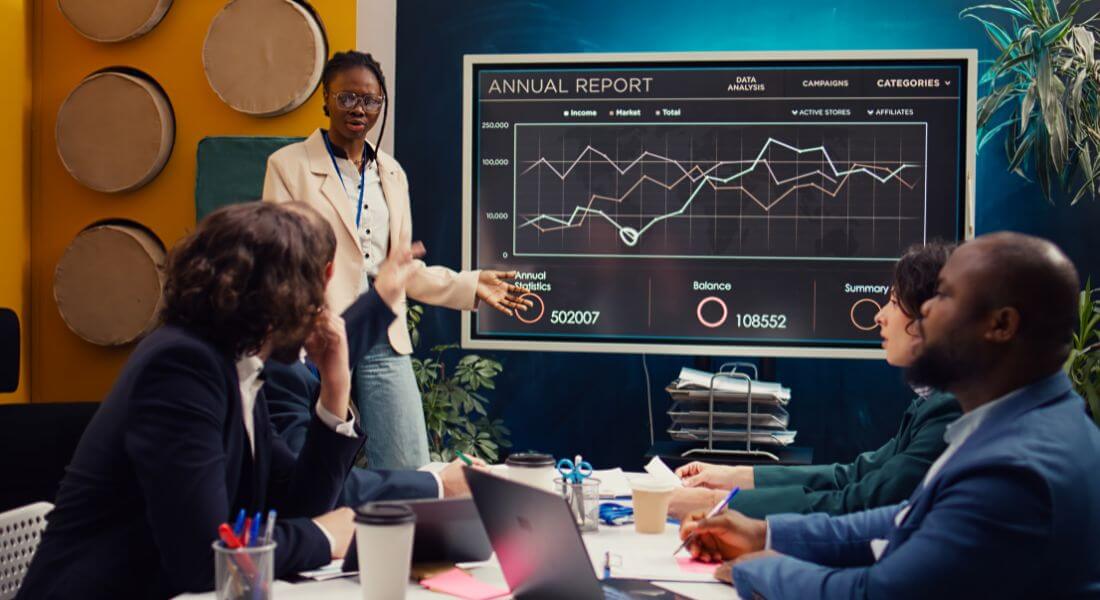
Animated data has the potential to do more than just look impressive it can tell powerful stories, guide viewers through insights, and make complicated information more digestible. When used effectively, data animations can spark curiosity, sustain attention, and help your audience grasp trends or comparisons that static visuals might miss. In fact, research shows that motion, when used sparingly and purposefully, can significantly enhance understanding and retention.
But let’s be honest: we’ve all sat through presentations or videos where animated graphs spin, bounce, or fly across the screen with no clear purpose leaving us more confused than informed. Bad animation doesn’t just look amateurish; it can overwhelm the viewer, obscure the message, or worse, make people tune out completely.
So how do you strike the right balance between clarity and creativity? How can you bring data to life without distracting from its meaning?
The secret lies in thoughtful, intentional design. Whether you’re building a dashboard, a social media visual, or a video explainer, every animated element should serve a clear purpose.
Let’s explore a few practical tips to help you animate data in a way that’s engaging, meaningful, and memorable so your visuals do more than just move. They tell a story.
Start with Purpose, Not Effects

Before diving into your animation software or experimenting with fancy transitions, take a step back and ask yourself a simple but essential question: What is the message I want to convey?
Too often, data animations fall into the trap of using motion as decoration adding spins, slides, and bounces just because they look cool. But animation, especially when applied to data, is not just about flair. It’s about communication. Every movement should be intentional, guiding the viewer through a story or insight with clarity and purpose.
Think of your animation as a visual sentence: each transition is a word, and together they should form a clear, coherent message. The goal isn’t to impress with effects but to enhance understanding.
Use animation to:
- Show change over time (like rising temperatures across years)
- Emphasize a comparison (like how one bar grows taller than another)
- Illustrate a cause-and-effect relationship (like how an increase in one value impacts another)
- Guide the eye through a sequence or flow (like a timeline or process)
Here are some key questions to ask before animating any data:
- What do I want the viewer to learn from this visual?
- Which element or trend should they notice first?
- Will this animation help simplify the data or confuse the message?
Remember, subtlety often wins. A simple fade or smooth transition can be more impactful than a dramatic zoom or flip. When you animate with intent and restraint, you don’t just make your visuals move you make them matter.
Use Visual Hierarchy to Guide the Eye
When presenting animated data, one of the most powerful principles you can apply is visual hierarchy a method of directing your viewer’s attention to the most important elements first, and then guiding them naturally through the rest. Just as writers use paragraphs and punctuation to organize ideas, designers use scale, contrast, timing, and motion to tell a visual story.
The purpose of your animation should be more than just adding movement it should lead the eye, showing your audience what to focus on, when, and why. When done right, it transforms data into a narrative that unfolds smoothly, without overwhelming or confusing the viewer.
Key Tips to Create an Effective Visual Hierarchy:
- Start with your main message: Identify the core insight or takeaway you want to communicate. Whether it’s a record-breaking number, a sudden drop, or a steady trend, this should be the first thing people notice.
- Use scale and colour to emphasize: Make key data points larger or bolder than the rest. Use a strong, contrasting colour to draw attention to important values or outliers, while keeping secondary information in muted tones.
- Control the timing of reveals: Don’t show all your data at once. Introduce elements gradually perhaps one chart segment at a time or one line of a graph per second to avoid cognitive overload and keep viewers engaged.
- Apply motion sparingly but purposefully: A slow upward movement can suggest growth; a bold zoom can spotlight a crucial number. But too much movement can create chaos. Use transitions and motion to support your message, not distract from it.
- Use labels and annotations to reinforce key points: Adding brief callouts or animated text alongside critical data can help viewers interpret what they’re seeing without having to guess.
If everything moves at the same pace or intensity, nothing feels important. That’s why it’s essential to let your animation breathe. Give each part of your visual enough space and time to make an impression before introducing the next. Think of it as directing a conversation one data point at a time.
Pacing Is Everything
One of the most overlooked but critical aspects of animated data is pacing. Pacing determines how quickly or slowly your visual information is delivered to your audience. Get it wrong, and even the best-designed animation can fall flat. Too fast, and your viewers won’t have enough time to absorb the content. Too slow, and they may lose interest, disengaging before your key message even arrives.
Think of pacing as the rhythm of your presentation. Just like a good speaker varies their tone and pauses for emphasis, a well-paced animation does the same guiding attention, creating anticipation, and giving space for understanding.
Why Pacing Matters:
- It sets the tone: A rushed animation can feel chaotic, while a slow one may seem dull. The right pace keeps the viewer engaged without overwhelming them.
- It supports comprehension: Viewers need time to read, interpret, and emotionally respond to the data. Pacing gives them breathing room to process the message.
- It emphasizes key moments: A well-timed pause or slower transition helps highlight significant changes or insights in the data.
How to Master Animation Pacing:
- Use quick transitions for simple concepts: If you’re showing a straightforward update like a value increasing slightly use a swift animation to maintain flow and energy.
- Slow down for complex comparisons: When comparing multiple datasets or trends, give each one time to be seen and understood before moving to the next. This allows for deeper engagement.
- Insert intentional pauses: Just like dramatic pauses in a speech, brief still moments in your animation give viewers a chance to absorb important information or build anticipation.
- Sync with narration or text: If your animation includes voiceover or captions, match the pacing of the visuals to the rhythm of the words. Misalignment can confuse or frustrate viewers.
- Test it aloud: Try narrating your animation while watching it. Does it feel rushed? Does it lag? If you’re stumbling or waiting for the animation to catch up, it’s time to tweak the timing.
Ultimately, great pacing feels invisible your audience stays engaged and informed without even realizing why. It’s what transforms static data into a smooth, flowing experience that captures attention and leaves a lasting impression.
Smart Transitions Build Context

Transitions in data animations are often underestimated. While they can add visual appeal, their true power lies in helping your audience understand change over time or between states. Transitions aren’t just for flair they’re essential tools for building narrative clarity and reinforcing data relationships.
A smart transition bridges the gap between “what was” and “what is,” guiding your audience through the evolution of the data. Done right, transitions provide context, prevent confusion, and ensure that shifts in the visual don’t feel abrupt or disconnected.
Why Thoughtful Transitions Matter:
- They show continuity: Rather than switching instantly from one chart type to another, transitions help the viewer track how one data point morphs into another.
- They reduce cognitive load: Without clear transitions, your audience may waste mental energy figuring out what changed, rather than understanding the insight.
- They maintain engagement: Smooth, purposeful motion keeps viewers visually anchored and focused on your story.
How to Use Transitions Intelligently:
- Connect related elements: For example, if you’re showing sales growth, animate bars increasing in height or morph a bar chart into a line graph that continues the same trend. This shows how one visual leads into the next.
- Highlight before-and-after comparisons: When showcasing the impact of a change like new data, an event, or a redesign use transitions to shift between the “before” and “after” states, helping viewers appreciate the contrast.
- Guide between sections: If your animation tells a multi-step story, use smooth transitions to move from one chapter to the next. This can include panning, fading, or morphing elements to maintain narrative flow.
- Stay subtle: Avoid over-the-top transitions like spins, bounces, or rapid zooms that distract rather than support comprehension. Clean, minimal movement is often the most effective.
Pro Tip: When planning transitions, ask yourself: Does this movement help the viewer understand the data better? If the answer is no, consider simplifying or removing it. Animation should serve the story not overshadow it.
In the end, smart transitions are about clarity, not decoration. When used with intention, they tie your visuals together and make your animated data not just beautiful, but meaningful.
Colour Should Clarify, Not Confuse

Colour is one of the most powerful tools in visual communication, especially when working with animated data. It can instantly draw attention, evoke emotion, or signify meaning. But without a clear strategy, it can just as easily mislead, overwhelm, or distract your audience.
In animated presentations, colour should do more than make things look attractive it should enhance understanding. Every hue and shade should serve a specific function in your visual narrative. When used with intention, colour becomes a silent guide, directing the viewer’s eye and reinforcing your message.
How to Use Colour Purposefully:
- Establish a consistent colour palette: Choose a limited set of colours that represent your categories or data points and stick with them throughout the animation. Random or inconsistent colouring can confuse viewers and make your animation feel disjointed.
- Use contrast to emphasise: Make important numbers, trends, or shifts stand out by using a bold or contrasting colour. This draws the eye to what matters most without shouting for attention.
- Group related data visually: Assign the same or similar colours to related categories or variables. This allows viewers to intuitively recognize connections and patterns within the animation.
- Show change or progression: Gradual colour shifts (like light blue to dark blue) are great for illustrating growth, change over time, or increasing intensity. This helps viewers understand the direction and scale of transformation without needing extra explanation.
What to Avoid:
- Too many colours: An overly colourful animation can become chaotic. If every bar, dot, or segment has a different hue, your audience may struggle to decode the meaning behind the visuals.
- Overly saturated or neon colours: Bright, flashy colours can cause eye fatigue and distract from your message. Opt for softer, more balanced tones unless you’re using a bold shade intentionally to highlight something.
- Unclear legends or missing labels: If you’re using colour to differentiate categories, make sure it’s accompanied by a clear legend or labels. Even the most beautiful palette means little if the viewer doesn’t know what it represents.
Pro Tip: Always test your colour scheme for accessibility, especially for colour-blind users. Tools like ColorBrewer or Adobe’s color contrast checker can help ensure your design is readable for all audiences.
Keep Text Minimal and Legible
Text plays a supporting role in animated data visuals. When used correctly, it provides essential labels, context, or summaries. But when overused or poorly formatted it can overwhelm the viewer, clutter the screen, or get lost entirely. The goal is to complement your visuals, not compete with them.
In animation, viewers process information moment by moment. They don’t have time to pause and read long sentences or decipher dense paragraphs. That’s why clarity and brevity are key. Keep your messaging crisp, your fonts readable, and your timing intentional.
Tips for Effective Text in Animated Data:
- Keep it short and simple: Aim for 6–10 words per line, max. If you need to explain more, split it into separate slides or use voiceover narration. Think headlines, not essays.
- Choose legible fonts: Stick with clean, sans-serif typefaces like Arial, Helvetica, or Roboto. These are easier to read at smaller sizes and on screens of all types.
- Ensure high contrast: Use a light font on a dark background or vice versa. Avoid low-contrast combinations (like gray on white), especially for small text, which can strain the viewer’s eyes.
- Use clear positioning: Place your text where it won’t overlap with important visuals. Anchor it consistently (e.g., always at the top-left) to maintain viewer orientation.
- Synchronise text with visuals: Animate text to appear when it’s most relevant. For example, reveal a label only when its corresponding data point is introduced. This keeps attention focused and avoids cognitive overload.
- Limit fonts and styles: Don’t use more than 1–2 typefaces. Keep bold, italics, and colours consistent to avoid a messy or disorganised look.
Bonus Tips:
- Use icons to reinforce meaning: Instead of writing out “click here,” pair a simple icon with the word “Click” to save space and increase comprehension.
- Test on small screens: Many viewers will watch your animation on mobile devices. Preview it to ensure that text remains readable at different resolutions and sizes.
- Don’t animate everything: Text flying in from all directions may look exciting, but it can be jarring or unnecessary. Use subtle fades, slides, or scale-ins that support not distract from the message.
Make It Interactive (When Possible)
Adding interactivity boosts engagement and comprehension. While not always feasible in videos, interactive dashboards or web animations let viewers explore data at their pace. You can highlight patterns that may go unnoticed in static or linear content.
Interactive techniques include:
- Hover-to-reveal comparisons
- Clickable filters or toggles
- Animated data explorers or timelines
Even small bits of interaction can go a long way.
Avoid Common Pitfalls
Don’t fall into the trap of flashy animations that add no value.
Here are a few things to avoid:
- Spinning charts with no purpose
- Overuse of bounce or slide effects
- Too many elements moving at once
- Using complex transitions for simple ideas
Simplicity and clarity should always be your north stars.
Test With Real Viewers
Sometimes what seems clear to you may confuse your audience. Test your animations on actual users or teammates. Watch where they pause, skim, or get stuck. Their reactions will tell you what needs fixing.
Ask them questions like:
- What’s the main insight you took away?
- Was anything confusing or too fast?
- Did the visuals help or distract?
Iterate based on feedback. Refinement makes a big difference.
Final Thoughts: Let Your Data Tell a Story
Animating data is part art, part science. The best animations guide viewers, not overwhelm them. With thoughtful pacing, meaningful transitions, and clear visual hierarchy, you can turn raw numbers into captivating stories.
If you’re looking for guidance or want to elevate your visual storytelling, our animation agency in London is here to help. We specialise in turning complex data into visuals that inform and inspire.

